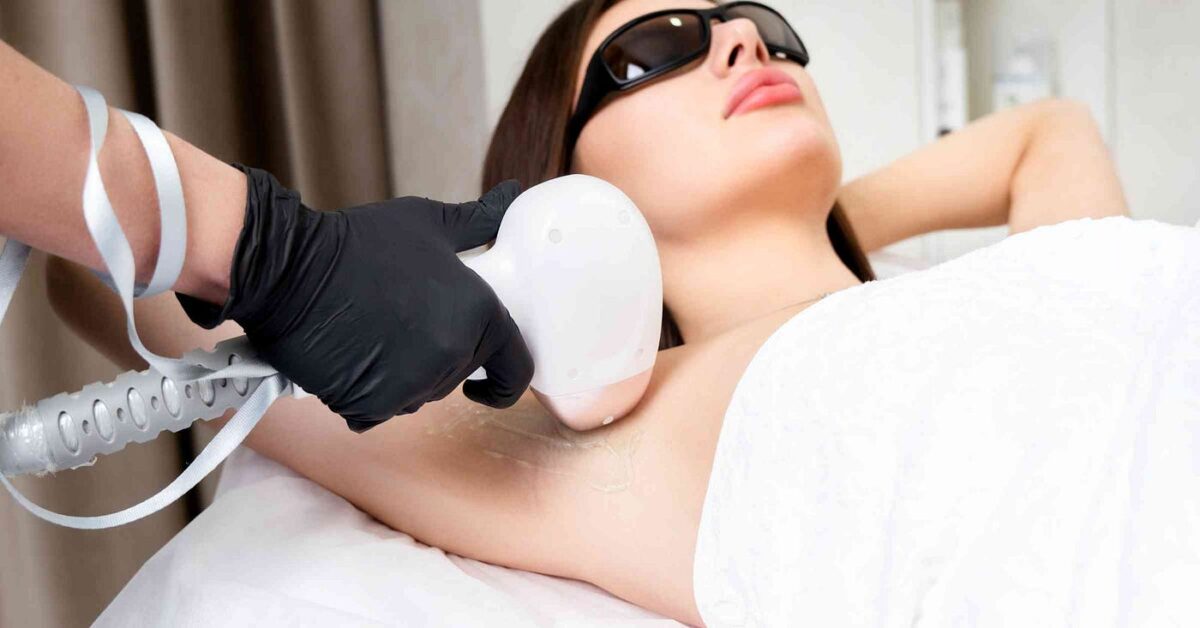Health
Traveling and Laser Hair Removal_ How to Keep Up with Your Treatments on the Go

Maintaining a regular laser hair removal schedule can be challenging for frequent travelers. Whether you’re traveling for work, vacation, or simply enjoying the adventure of exploring new places, keeping up with your treatments is essential to achieve and maintain smooth, hair-free skin.
The Importance of Consistency in Laser Hair Removal
Laser hair removal works by targeting hair follicles in their growth phase. Since not all hair follicles are active at the same time, multiple sessions are required to achieve the desired results. Consistency in treatment intervals is crucial to ensure that all hair follicles are effectively targeted, leading to long-lasting hair reduction. Disrupting your treatment schedule can prolong the process and affect the overall effectiveness of the treatment.
Planning Your Treatment Schedule
Schedule Around Your Travel Plans
When planning your laser hair removal sessions, consider your travel schedule. Try to book your appointments around your trips to avoid long gaps between treatments. Communicate with your laser hair removal specialist to create a treatment plan that accommodates your travel plans without compromising the effectiveness of the treatments.
Book Appointments in Advance
If you know your travel dates in advance, book your laser hair removal appointments ahead of time. This ensures that you secure your preferred time slots and maintain consistency in your treatment schedule. Many med spas offer online booking options, making it easy to manage your appointments even when you’re on the go.
Preparing for Travel
Follow Pre-Treatment Guidelines
Before you travel, make sure to follow all pre-treatment guidelines provided by your laser hair removal specialist. This typically includes avoiding sun exposure, tanning, and certain skincare products. Preparing your skin appropriately ensures that your treatments remain effective and minimizes the risk of adverse reactions.
Pack Essential Skincare Products
Traveling can expose your skin to different environmental factors. Pack essential skincare products, including sunscreen, moisturizer, and gentle cleansers, to protect and care for your skin while you’re away. Avoid using harsh products that could irritate your skin, especially around treatment areas.
Finding Treatment Options While Traveling
Research Local Med Spas
If you’re traveling for an extended period, consider researching local med spas at your destination. Look for reputable establishments that offer laser hair removal services and have good reviews. This allows you to continue your treatments without interruption and ensures that you maintain progress.
Consult with Your Regular Specialist
Before seeking treatment at a new location, consult with your regular laser hair removal specialist. They can provide guidance on what to look for in a new provider and may even recommend trusted clinics in your destination. Maintaining communication with your specialist ensures that you receive consistent and safe treatment.
Managing Post-Treatment Care on the Go
Protect Your Skin
After a laser hair removal session, your skin may be more sensitive to the sun and other environmental factors. Protect your skin by applying a broad-spectrum sunscreen with an SPF of 30 or higher. Wear protective clothing and seek shade whenever possible to prevent sunburn and irritation.
Stay Hydrated and Moisturized
Traveling can dehydrate your skin, especially when flying or visiting dry climates. Drink plenty of water and use a hydrating moisturizer to keep your skin healthy and supple. This helps maintain the results of your laser hair removal treatments and promotes overall skin health.
Choosing the Right Med Spa
Selecting a reputable med spa is crucial for ensuring safe and effective laser hair removal treatments. SEV Laser is renowned for its commitment to excellence and innovative cosmetic solutions. Their team of skilled practitioners specializes in laser hair removal and provides personalized treatment plans tailored to each client’s needs. With SEV’s new location in Salt Lake City, it offers state-of-the-art technology and exceptional service in a comfortable and welcoming environment. Choosing SEV Laser guarantees that you receive the highest quality care, helping you achieve and maintain smooth, hair-free skin even when traveling.
Conclusion
Keeping up with your laser hair removal treatments while traveling is essential for achieving and maintaining long-lasting results. By planning your treatment schedule around your travel plans, preparing appropriately, and finding reputable med spas on the go, you can ensure that your progress remains uninterrupted. Protecting your skin post-treatment and staying hydrated further enhances the effectiveness of your sessions.
With the right planning and care, you can enjoy the benefits of laser hair removal no matter where your travels take you.
Health
How Hyperbaric Oxygen Therapy Can Boost Brain Health

What Is Hyperbaric Oxygen Therapy (HBOT)?
Hyperbaric Oxygen Therapy (HBOT) is a treatment that involves inhaling oxygen in a chamber. Originally created to help divers with decompression sickness, HBOT now has uses. One notable application is its potential to improve brain health and cognitive abilities attracting attention worldwide including in clinics in Dubai that offer treatments like Dubai Oxygen.
HBOT is an invasive therapy used for managing different conditions such as severe infections and chronic wounds that do not respond well to standard treatments. This therapy allows individuals to breathe in levels of oxygen in a setting aiding quicker healing and cell regeneration. It serves as an option for those who have not seen improvement with medical approaches providing a new path towards recovery and well-being.
How HBOT Works in the Body
During an HBOT session, patients enter a hyperbaric chamber where the air pressure is increased to two or three times higher than pressure. This heightened pressure enables the lungs to absorb oxygen compared to air intake. The oxygen enriched blood travels throughout the body reaching damaged tissues and supporting the body’s natural healing mechanisms.
The boosted availability of oxygen not only improves the ability for tissue repair. It also triggers the release of growth factors and stem cells. These natural agents play a role in regenerating damaged tissues, including those found in the brain. By saturating the body with oxygen HBOT can speed up the healing process and lessen inflammation. Boost the body’s defense against infections and other health issues. This makes it a valuable tool for addressing conditions beyond just brain health.
Benefits of HBOT for Brain Health
The benefits of HBOT are increasingly well-documented. Improved oxygenation in the brain can lead to enhancements in functions like memory, concentration and mental sharpness. For instance individuals dealing with traumatic stress disorder (PTSD) have reported reduced symptoms following HBOT sessions. The therapy’s ability to enhance oxygen delivery to the brain can enhance activity supporting cognitive function and mental wellness.
Moreover hyperbaric oxygen therapy shows promise for individuals facing conditions such as Alzheimer’s and Parkinson’s diseases. Higher levels of oxygen in the brain might help alleviate some symptoms linked to these diseases by reducing inflammation and oxidative stress. This could lead to a quality of life for patients offering hope to those grappling with challenging conditions.
Scientific Evidence Supporting HBOT
Ongoing studies along with cases are continuously revealing the range of potential benefits that HBOT (Hyperbaric Oxygen Therapy) may offer for brain health. Scientific research strongly supports the effectiveness of HBOT showing enhancements in individuals who have undergone the therapy. A study published in the Neurotrauma journal found that patients demonstrated improved functions and a better quality of life HBOT sessions highlighting its potential to enhance brain health.
Furthermore a recent study in 2020 suggested that HBOT could help reduce inflammation and oxidative stress both known contributors to decline. These findings emphasize HBOT’s role as a treatment option for improving health and cognitive abilities. With an increasing body of evidence backing it up, HBOT is emerging as a therapeutic approach for various brain-related conditions.
Things to Consider Before Trying HBOT
Before considering HBOT, it is essential to undergo an evaluation to ensure its suitability for your individual circumstances.
Certain Health Conditions: Lung diseases or infections may make the treatment unsuitable for some individuals. Seeking guidance from healthcare professionals will help determine whether HBOT is safe and beneficial for you.
Possible Adverse Reactions: Although generally deemed safe, HBOT may lead to side effects such as sinus discomfort ear pressure and in cases oxygen toxicity. It is crucial to have a conversation about these risks with your healthcare provider and keep an eye out for any reactions while undergoing treatment.
Expenses and Availability: HBOT can be costly. Not all insurance plans provide coverage for it. Additionally the accessibility of hyperbaric chambers may vary depending on your location. It is important to take into account the logistical aspects of receiving HBOT and explore options for financial assistance.
Summary
Hyperbaric Oxygen Therapy offers an approach to enhancing brain health by increasing oxygen levels. This treatment can lead to improved function relief from symptoms of conditions and enhanced overall mental well-being. While further research is needed current scientific evidence and personal accounts are positive. Always consult with a healthcare professional to determine if HBOT is suitable for your health requirements.
Health
The Benefits of Cosmetic Teeth: Enhance Your Smile Today

A beautiful smile can change everything. Many people seek ways to enhance their appearance through cosmetic teeth. These treatments offer a range of aesthetic dental solutions.
Have you ever wondered how a vibrant smile could boost your confidence? Procedures like teeth whitening, veneers, and bonding make a significant difference. They are designed to improve your smile’s look and feel.
With today’s advanced technology, achieving a perfect smile is easier than ever. Explore how cosmetic teeth can transform your self-image and provide you with the aesthetic you desire. Let’s dive into the benefits of these innovative solutions!
Boosted Confidence
Having a beautiful smile can boost your confidence. When you feel good about your teeth, you are more likely to smile often. This can make social interactions easier and more enjoyable.
People who enhance their smiles through cosmetic dental treatments often report feeling less shy and more willing to engage in conversations. A bright, attractive smile can draw others in and make a positive first impression. It can help you feel more confident in:
- job interviews
- social gatherings
- life moments
Simple changes like whitening teeth or adding veneers can lead to a newfound sense of self-assurance. It allows you to express yourself freely and confidently.
Improved Oral Health
Cosmetic dental treatments enhance your appearance. It can also lead to improved oral health. For instance, procedures like veneers can protect your teeth from damage and decay, effectively acting as a shield.
When you invest in your smile, you often become more mindful of your dental care services. This heightened awareness encourages regular check-ups and proper hygiene practices, such as:
- brushing
- flossing
People who pursue cosmetic treatments experience a greater motivation to maintain their oral health. It results in healthier gums and stronger teeth.
The journey to a better smile is closely connected to oral wellness. It makes cosmetic dentistry a wise choice for both beauty and health.
Youthful Appearance
Cosmetic dental treatments, particularly types of dental veneers, can contribute to a more youthful appearance. As we age, our teeth can become discolored, worn, or misshapen, which may lead to a tired or older look.
By applying dental veneers, which are thin shells that cover the front of your teeth, you can achieve a brighter and more even smile. This simple transformation helps create a fresher facial appearance, as a radiant smile can take years off your look.
Many people find that improving their smile allows them to feel and appear younger. With a youthful smile, you radiate energy. It makes a lasting impression on others.
Personalized Solutions
In cosmetic dentistry, one of the greatest advantages is the ability to create personalized solutions tailored to each individual’s needs. Every smile is unique, and cosmetic treatments can be customized based on factors such as:
- tooth shape
- color
- alignment
During an initial consultation, a dentist will assess your smile and discuss your goals to develop a treatment plan that works best for you. Whether you need whitening, veneers, or orthodontics, these personalized solutions ensure that your smile enhancement fits your desires and lifestyle.
This level of customization improves your smile. It also enhances your dental experience. It makes it a rewarding journey toward achieving the smile you have always wanted.
Pain Reduction
Cosmetic dental procedures can also lead to pain reduction in several ways. Many treatments, like dental bonding or crowns, are designed to fix issues such as cracks or decay, which can cause discomfort.
By repairing these problems, you not only improve your smile but also relieve pain associated with damaged teeth. Additionally, those who receive orthodontic treatments, such as braces, often report discomfort decreases as their teeth shift into the correct position.
With improved alignment, many individuals experience less strain on their jaw and reduced headaches. By investing in cosmetic dentistry, you address aesthetic concerns and any pain. It leads to a more comfortable and pleasant dental experience.
Long-lasting Results
One of the benefits of cosmetic dental treatments is their ability to deliver long-lasting results. Procedures like teeth whitening, veneers, and crowns can enhance your smile and maintain its beauty for years with proper care.
For instance, professional teeth whitening can brighten your smile quickly. It maintains it requires good oral hygiene, such as brushing and flossing regularly. Similarly, dental veneers are durable and can last over a decade when cared for properly.
By making simple lifestyle changes, like avoiding excessive staining foods and drinks, you can extend the life of your cosmetic treatments. This longevity means investment in a beautiful smile provides value beyond the initial treatment.
Versatility
One of the key advantages of cosmetic dental treatments is their versatility. Whether you want to address minor imperfections or make significant changes to your smile, numerous options are available to fit your needs.
Treatments such as whitening, bonding, and veneers can be used alone or combined to achieve the desired aesthetic treatment. For example, if you have stained teeth, a simple whitening procedure can rejuvenate your smile.
If you want to close gaps or fix chips, bonding or veneers can offer quick solutions. This flexibility means you can choose the right combination of treatments based on your goals, making it easier than ever to achieve a bright and attractive smile tailored to your unique preferences.
Enhanced Functionality
Cosmetic dental treatments do more than improve the way your smile looks; they can also enhance how your teeth function. For instance, procedures like crowns and bridges can restore damaged teeth, allowing you to chew food properly without discomfort.
When your teeth are aligned correctly through treatments like braces or clear aligners, you not only achieve a beautiful smile but also make it easier to bite and process your food. Improved alignment helps reduce wear on your teeth and jaws, leading to less pain and strain over time.
When your teeth are attractive and functional, you can enjoy a better quality of life. It makes eating and speaking much more enjoyable and effortless.
Discover the Benefits of Cosmetic Teeth
Cosmetic teeth can enhance your life. They boost your confidence and improve your smile. With options like whitening and veneers, you can achieve stunning results.
These treatments also benefit your oral health and comfort. Investing in cosmetic teeth pays off with long-lasting effects. You deserve to feel good about your smile.
Take the step today to explore cosmetic dental options. A brighter smile awaits you, transforming how you feel and interact.
Did you find this article helpful? If so, check out the rest of our site for more informative content.
Health
Uncovering the Truth: The Ins and Outs of Canadian Pharmacy Reviews

Are you curious about Canadian pharmacy reviews? Finding reliable information is crucial. Many people turn to these reviews for guidance. They help you gauge the quality and safety of pharmacies.
In this blog, we will explore the ins and outs of Canadian pharmacy reviews. You will learn what to look for and how to interpret them. This ensures you make informed choices. Get ready to navigate the world of Canadian pharmacy reviews with confidence!
Understanding the Concept of Virtual Pharmacies
Virtual pharmacies are online stores where you can buy medications. They are convenient because you can order from your home. These pharmacies often have better prices than local stores.
It is important to ensure a virtual pharmacy is safe. Check if it has a valid license and good reviews. Always avoid sites that do not ask for a prescription when needed.
The Allure of Canadian Drugs
Canadian drugs have become increasingly popular due to their affordability and accessibility. Many people look to Canada for cheaper prescriptions. This helps those who cannot afford high prices in their own countries.
Another benefit is the ease of getting medications online. Virtual pharmacies offer a simple way to order what you need. Just make sure to choose a licensed and well-reviewed site.
Key Factors to Consider in Canadian Pharmacy Reviews
When looking at Canadian pharmacy reviews, check for customer satisfaction. Read about their experience with delivery times and customer service. Positive reviews can indicate a reliable pharmacy.
Another key factor is the quality of the medications. Ensure the reviewers mention that the drugs are effective and safe. Always avoid pharmacies with complaints about counterfeit medications.
Spotting Red Flags in Canadian Pharmacy Reviews
Not all reviews are created equal, and some may even be misleading. It’s important to spot red flags that may indicate a pharmacy is not trustworthy. Reviews that are overly positive without any constructive criticism, or multiple reviews posted within a short timeframe, should raise concerns.
Pay attention to reviews that mention delayed deliveries or poor customer service. These are signs that the pharmacy may not be reliable. Also, be cautious if there are complaints about questionable product quality.
The Final Check-Out
Now that you know what to look for in an ideal online pharmacy, it’s time to put your knowledge into practice. Carefully review the options available and trust verified sources. It might be worthwhile to check out Canadian pharmacy online for a reliable experience.
Keep these tips in mind when navigating Canadian pharmacy reviews, and you’ll be on your way to finding a reliable source for all your medication needs. Use this knowledge responsibly and always consult with a healthcare professional before making any changes to your medication regimen.
Empowered Choices with Canadian Pharmacy Reviews
Canadian pharmacy reviews empower you to make safe and cost-effective choices. By understanding what to look for and spotting red flags, you can confidently select a reliable pharmacy. Always consider customer satisfaction, delivery times, and medication quality in your search.
Using reviews from trusted sources helps you avoid unsafe options. Remember, being informed means you can navigate your healthcare needs with ease. Use these tips wisely for a successful and stress-free experience.
Did you find this article helpful? Visit more of our blogs!
-

 Tech5 months ago
Tech5 months agoExploring the Features of Innocams: The Future of Security
-

 Home Improvement3 months ago
Home Improvement3 months agoEco-Friendly Round Rug Options for Sustainable Living in NZ
-

 How-To Guides2 months ago
How-To Guides2 months agoComprehensive Guide to Cockwarming: Enhancing Intimacy and Connection
-

 Fashion3 months ago
Fashion3 months agoBlack Magic: The Elegance and Sophistication of Ultimate Homecoming Dresses in Black
-

 Apps and Games3 months ago
Apps and Games3 months agoDiscover Tickzoo: The Ultimate Platform for Video Content Lovers and Creators
-

 Business5 months ago
Business5 months agoUnlock Potential: Explore Pikruos Services
-

 Blog3 weeks ago
Blog3 weeks agoPossiblyethereal: Exploring the Ethereal Unveiling Abstract Ideas
-

 Entertainment4 months ago
Entertainment4 months agoDiving into the Audio-Visual Experience with AV Tub: Innovating Our World of Media
















